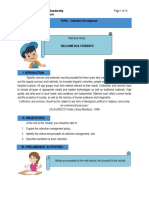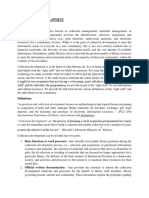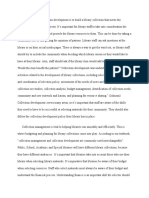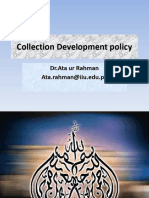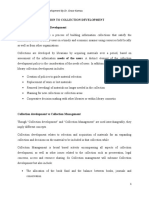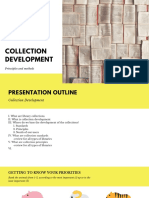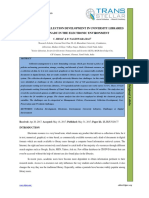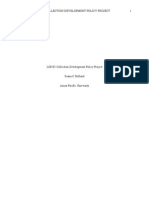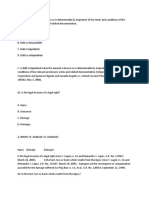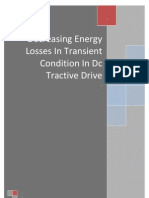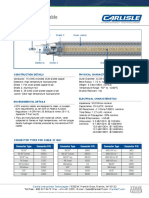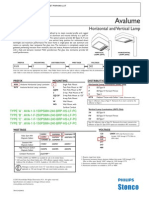LST 112- COURSE PACK ON SPECIAL/PUBLIC LIBRARIANSHIP
1|Page
� LST 112- COURSE PACK ON SPECIAL/PUBLIC LIBRARIANSHIP
Special/Public Librarianship
Disclaimer:
No part of this publication maybe reproduced, stored in a
retrieval system or transmitted in any form transmitted in
any form or by any means, electronic, mechanical,
photocopying, recording or otherwise, without the prior
written consent of the author. All rights reserved.
CINDY C. MOLDES
2|Page
� LST 112- COURSE PACK ON SPECIAL/PUBLIC LIBRARIANSHIP
Lesson 4: Collection Development
This lesson introduces you to the collection management and development of
special libraries. In this lesson, you will also be acquainted with how library
materials are selected and the use of selection tools.
Learning Outcomes:
At the end of this lesson, you should be able to:
• Discuss the process of developing the collection.
• Compare and contrast the difference between collection management and
development.
• Explain the policies for book selection.
• Discuss the selection process
Time Frame: Week 6
45 | P a g e
� LST 112- COURSE PACK ON SPECIAL/PUBLIC LIBRARIANSHIP
ACTIVITY
By now, you must have a bird's eye view of the collection development of special
libraries. Before you go further, establish your own learning goals by
accomplishing the My Smart Goal Worksheet below.
46 | P a g e
� LST 112- COURSE PACK ON SPECIAL/PUBLIC LIBRARIANSHIP
ANALYSIS
Answer the following
questions below.
1. What is the difference between collection
management and collection development?
_______________________________________
_______________________________________
2. How are library materials selected?
_______________________________________
_______________________________________
3. State the importance of book selection
policies.
_______________________________________
_______________________________________
47 | P a g e
� LST 112- COURSE PACK ON SPECIAL/PUBLIC LIBRARIANSHIP
ABSTRACTION
Collections
A special library's focus was to collect the substantial and recorded knowledge in
books, journals, reference materials, and other documents in earlier times. In
contrast, today, the library's focus has shifted to embrace new formats such as
online sources and intangible knowledge. The profound characteristic of online
resources, such as electronic journals, e-books, and databases, is that the
research library does not own but has access to them.
The special library has usually regarded as its primary objective and obligation to
adopt, gather, keep and include collections of materials that are broadly produced
by the organization as intangible knowledge: daily correspondence, technical
reports, and investigation made for clients, results of research, and publications
(Marion, 1910: 401).
It acquires resources, knowledge, and data pertinent to the work of the
organization. Thus, it heavily relies on electronic resources in addition to the
conventional material and aspires to keep the collection up to date. This is also
why we deem in this book that a special library is a proper place to handle,
organize, and disseminate the knowledge created throughout the company and
disseminate the knowledge created throughout the company.
Because competition between counterparts is high, companies are interested in
research to develop their activities and services. Consequently, the special library
has to follow these actions by keeping the collection current, compatible, and
48 | P a g e
� LST 112- COURSE PACK ON SPECIAL/PUBLIC LIBRARIANSHIP
comprehensive. Of course, it all depends on the funding and support of the parent
organization.
Collections and personnel expertise are the key components that mark special
libraries' contribution to the library world. It is essential to figure out how the
collection is used, rather than to know how many times each item is used. Although
the electronic resources occupy a generous portion of the collection of a special
library, it is impossible that they will entirely replace all traditional material of a
collection.
For years to come, libraries will be hybrid because they will hold both print and
non-print material. A drawback of using only electronic journals is that dropping a
subscription means that access to the current and back files frequently drops and
disappears from the library's ability to access the information purchased in previous
years (Mount and Massoud, 1999: 179). For a special library, the periodicals
collection comprises a rigorous component of the whole collection. It holds the core
journals of the main disciplines of the organization. Reference tools, such as
abstracting and indexing services, are adequate means to locate articles of interest
in print or electronic format.
Collections of special libraries are designed to be used by their clients. The library
must encourage the patrons to make suggestions for new material in any format.
Thus, the patrons help libraries in collection development. In that way, the library
incorporates new fields and leaves others out in line with the user demands for
current information.
Consequently, it is necessary that the library fosters good relations with employees
and regards employees as its associates. Many special libraries keep records and
archives in their collection. Records are current documents dealing with the life of
the organize devices, microforms, and photographs. There is a retention policy for
records.
On the contrary, archives are characterized by longevity in retaining their records
because they chiefly have historical value for the organization, such as the archive
49 | P a g e
� LST 112- COURSE PACK ON SPECIAL/PUBLIC LIBRARIANSHIP
of the governor of the organization and the archive of the building's architectural
drawings.organisation and the archive of the architectural drawings of the building.
COLLECTION MANAGEMENT AND DEVELOPMENT
Collection development came into wide use in the late 1960s to replace selection
as a more encompassing term reflecting the thoughtful process of developing a
library collection in response to institutional priorities and community or user needs
and interests.
Collection development was understood to cover several activities related to the
development of library collections, including selection, the determination and
coordination of selection policy, assessment of the needs of users and potential
users, collection use studies, collection analysis, budget management,
identification of collection needs, community and user outreach, and liaison, and
planning for resource sharing.
In the 1980s, the term collection management was proposed as an umbrella term
under which collection development was subsumed. In this construct, collection
management includes collection development and an expanded suite of weeding,
canceling serials, storage, and preservation decisions.
Also of concern in collection management are the organization and assignment of
responsibilities for its practice. Collection management and collection development
are now often used synonymously or in tandem. For example, the American Library
Association's (ALA) Association for Library Collections and Technical Services'
professional organization that focuses on this topic is called the Collection
Management and Development Section. The Reference and User Services
Association's section is called the Collection Development and Evaluation Section,
more commonly referred to as CODES.
The tasks, functions, and responsibilities now understood to be the portfolio of The
tasks, functions, and responsibilities are now understood to be the portfolio of
collection development. Librarians include the selection of materials in all formats,
collection policies, collection maintenance (selection for weeding and storage,
preservation, and serials cancellation), budget and finance, assessment of needs
50 | P a g e
� LST 112- COURSE PACK ON SPECIAL/PUBLIC LIBRARIANSHIP
of users and potential users, liaison and outreach activities related to the collection
and its users, collection assessment and evaluation, and planning for cooperation
and resource sharing.
A literature sampling provides a clearer understanding of how practitioners
understand collection development and management:
Standards for Collection Development
A. Collection Development -- is dependent on the following:
1. Scope is dependent on the mission/vision, function and type of library service
for each institution.
2. Size is likewise dependent on the same criteria
3. Growth of the collection is dependent on the budget allotment or fund
allocation of the institution.
51 | P a g e
� LST 112- COURSE PACK ON SPECIAL/PUBLIC LIBRARIANSHIP
B. Organization
1. Collection must be systematically organized according to generally accepted
standard classification, e.g. Dewey Decimal Classification (DDC), Library of
Congress (LC), and other recognized classification scheme.
2. Indexing should be observed.
The Book Selection policy for Special Library
Special Library is a library or information center, maintained by an individual,
corporation, association, government agency or any other group; or a specialized
or department collection within a library. For the development of its collection,
special library maintain some selection policies. This includes:
1. Selection policies of special library must be established within the form of the
libraries stated objectives.
2. The subject coverage special libraries collection must be intensive and
extensive. The collection mixed the current anticipated information
requirements of library clientele.
3. It is advisable to have a library committee consisting of specialist who can give
advice on book selection and purchase.
How are Library Materials Selected
The library director/manager uses selection tools in acquiring and selecting
library/materials. There are several kinds of tools that help him/her decide what
library materials to select and acquire. Publishers have their lists which the library
manager/director can use.
52 | P a g e
� LST 112- COURSE PACK ON SPECIAL/PUBLIC LIBRARIANSHIP
For example, Books in Print (BIP), Book Review Index, Forthcoming Books, and
New Technical Books. For special materials, titles like Directory of Newspapers
and Periodicals, Business Pamphlets, and Information Sources are tools librarians
can use.
The librarian can also use reviews and annotations published in some reviewing
journals and publications such as Library Journal. Recommendations and
suggestions are a big help because of direct communication between the selector
and clientele.
Note:
Please also see in the Appendices page 145, the Professional Regulatory Board
for Librarians Resolution no. 01 series of 2016 on Prescription, Issuance, and
Promulgation of the “Standards for Special Libraries in the Philippines.”
53 | P a g e
� LST 112- COURSE PACK ON SPECIAL/PUBLIC LIBRARIANSHIP
APPLICATION
Use your online or paper journal to jot your learnings about the special library
collection and selection policy. Also, write your thoughts about the lesson using
the exit ticket below:
54 | P a g e
� LST 112- COURSE PACK ON SPECIAL/PUBLIC LIBRARIANSHIP
Answers to all activities, and exercises may be submitted via UVE submission
link, messenger, email, or post.
CLOSURE
Congratulations on completing lessons #4 in the first module of this course.
You may proceed to the next lesson, services, facilities, financial resources,
linkages, and networking.
55 | P a g e
